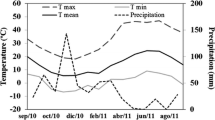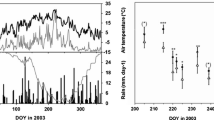Abstract
The annual course of frost resistance (LT50) and the pH of the cell effusate in needles of two-year-old Scots pine seedlings were monitored in a field experiment in Oulu, Northern Finland (65° N, 25° E) during 1995. The aim of the work was to to develop model to predict the annual variation in frost resistance by pH of the cell effusate and meteorological data. The seedlings were covered with a fibre cloth shelter which transmitted sufficient light for them to experience the photoperiod, but prevented the accumulation of snow over them. The shelter above the seedlings was removed at the beginning of May and erected again at the end of September. The seedlings were watered only for the time when the shelter was removed, and received fertilizer only during the previous summer (1994).
Frost resistance was only -5° C during the growing season but more than -100° C during the winter rest period. It was about -10° C at the end of August, increased to -55° C in the next three weeks, and reached -100° C at the beginning of October. The pH of the cell effusate was lowest during the growing season and highest in winter, the difference being about one and half pH unit. Needles exposed to -196° C showed pH from 4.0 in summer to 5.5 in winter, while pH of the non-frozen needles varied from 5.0 to 6.5, respectively. Seasonal variation in frost resistance was explained by a regression model well (R2 = 0.9) when day length, minimum air temperature and pH were entered as variables.
Similar content being viewed by others
References
Aronsson, A. 1975. Influence of photo-and thermoperiod on the initial stages of frost hardening of phytotron-grown seedlings of Scots pine (Pinus silvestrisL.) and Norway spruce (Picea abies[L.] Karst.). Studia Forestalia Suecica 128: 1-21.
Aronsson, A. 1980. Frost hardiness in Scots pine (Pinus sylvestrisL.) II. Hardiness during winter and spring in young trees of different mineral status. Studia Forestalia Suecica 155: 1-27.
Barnes, J. D. & Davison, A. W. 1988. The influence of ozone on the winter hardiness of Norway spruce (Picea abies[L]. Karst.). New Phytol. 108: 159-166.
Bigras, F. J. & D’Aoust, A. 1993. Influence of photoperiod on shoot and root frost tolerance and bud phenology of white spruce seedlings (Picea glauca). Can. J. For. Res. 23: 219-228.
Burke, M. J, Gusta, L. V, Quamme, H. A, Weiser, C. J. & Li P. H. 1976. Freezing and injury in plants. Ann. Rev. Plant Phys. 27: 507-528.
Cannell, M. G. R. 1990. Modelling the phenology of trees. Silva Carelica 15: 11-27.
Caporn, S. J. M., Risager, M. & Lee, J. A. 1994. Effect of nitrogen supply on frost hardiness in Calluna vulgaris(L.) Hull. New Phytol. 128: 461-468.
Christersson, L. 1973. The effect of inorganic nutrients on water economy and hardiness of conifers. Studia Forestalia Suecica 103: 1-26.
Christersson, L. 1978. The influence of photoperiod on the development of frost hardiness in seedlings of Pinus sylvestrisand Picea abies. Physiol. Plantarum 44: 288-294.
Christersson, L. & von Fircks H. 1990. Frost and winter desiccation as stress factor. Aquilo Series Bot. 29: 13-19.
Dexter, S., Tottingham, W. & Graber, L. 1932. Investigations on the hardiness of plants by measurement of electrical conductivity. Plant Physiol. 7: 63-78.
Dueck, T. A, Dorél, F. G, Ter Horst, T. R. & Van Der Eerden, L. M. J. 1990. Effects of ammonia, ammonium sulphate, and sulphur dioxide on the frost sensitivity of Scots pine (Pinus sylvestrisL.). Water, Air, Soil Pollut. 54: 35-49.
Fuchigami, L. H., Weiser, C. J., Kobayashi, K,. Timmis, R. & Gusta, L. V. 1982. A degree growth stage ( ° GS) model and cold acclimation in temperate woody plants. Pp. 93-116. In: Li, P. H. & Sakai, A. (eds.), Plant Cold Hardiness and Freezing Stress. Mechanisms and Crop Implications, Vol. 2. Academic Press, New York.
Grignon, C. & Sentenec, H. 1991. pH and ionic conditions in the apoplast. Ann. Rev. Plant Physiol. Plant Mol. Biol. 42: 103-128.
Hansen, J. M. 1992. Effects of nutritional factors on frost hardening in Larix leptolepis (Sieb and Zucc.) Gord. Scand. J. For. Res. 7: 183-192.
Havas, P. 1971. The water economy of the bilberry (Vaccinium myrtillus) under winter conditions. Rep. Kevo Subarctic Res. Stat. 8: 41-52.
Havas, P. 1985. Winter and boreal forests. Aquilo Series Bot. 23: 9-16.
Hellergren, J. 1981. Frost hardiness development in Pinus sylvestrisseedlings in response to fertilization. Physiol. Plantarum 52: 297- 301.
Husted, S. & Schjoerring, J. K. 1996. Ammonia flux between oilseed rape plants and the atmosphere in response to changes in leaf temperature, light intensity, and air humidity. Interactions with leaf conductance and apoplastic NH4 + and H+ concentrations. Plant Physiol. 112: 67-74.
Huttunen, S., Kärenlampi, L. & Kolari, K. 1981. Changes in osmotic potential and some related physiological variables in needles of polluted Norway spruce (Picea abies). Ann. Bot. Fennici 18: 63-71.
Ingestad, T. 1973. Mineral nutrient requirements of Vaccinium vitisidaeaand V. myrtillus. Physiol. Plantarum 29: 239-246.
Kellomäki, S., Hänninen, H. & Kolström, M. 1995. Computations on frost damage to Scots pine under climatic warming in boreal conditions. Ecol. Appl. 5: 42-52.
Larcher, W. 1995. Physiological plant ecology. 493 pp. Springer-Verlag, Berlin.
Levitt, J. 1972. Responses of plants to environmental stresses. 2nd Ed. 697 pp. Academic Press, New York.
Lucas, P. W., Cottam, D. A,. Sheppard, L. J. & Francis, B. J. 1988. Growth responses and delayed winter hardening in Sitka spruce following summer exposure to ozone. New Phytol. 108: 495-504.
Lähdesmäki, P. & Pietiläinen, P. 1989. Seasonal variation in nitratereductase activity and concentration of NO3- NO2- and NH4 +in the buds and needles of Scots pine. Aquilo Series Bot. 26: 7–11.
Margolis, H. A. & Vézina L-P. 1990. Atmospheric CO2 enrichment and development of frost hardiness in containerized black spruce seedlings. Can. J. For. Res. 20: 1392-1398.
Pietilä, M., Kuusipuro, P., Pietiläinen, P. & Lähdesmäki, P. 1989. Specificity and seasonal variation of arginase, glutamate synthase and nitrate reductase activities in Scots pine needles. Plant Sci. 64: 153-160.
Pietiläinen, P., Poikolainen, J. & Lähdesmäki, P. 1991. Long-term monitoring of nitrate reductase activity in the needles of Pinus sylvestrisin the context to the environmental temperature and ground frost as an indicator of nitrogen balance in N Finland. Ann. Bot. Fennici 28: 131-134.
Pomeroy, M. K., Siminovitch, D. & Wightman, F. 1970. Seasonal biochemical changes in the living bark and needles of red pine (Pinus resinosa) in relation to adaptation to freezing. Can. J. Bot. 48: 953-967.
Raven, J. A. & Smith, F. A. 1976. Nitrogen assimilation and transport in vascular plants in relation to intracellular pH regulation. New Phytol. 76: 415-431.
Raven JA. 1986. Biochemical disposal of excess H+ in growing plants? New Phytol. 104: 175-206.
Repo, T., Mäkelä, A. & Hänninen, H.. 1990. Modelling frost resistance of trees. Silva Carelica 15: 61-74.
Sakai, A. 1979. Freezing avoidance mechanism of primordial shoots of conifer buds. Plant Cell Physiol. 20: 1381-1390.
Sakai, A. 1983. Comparative study on freezing resistance of conifers with special reference to cold adaptation and its evolutive aspects. Can. J. Bot. 61: 2323-2332
Sakai, A. & Larcher, W. 1987. Frost Survival of Plants. Responses and Adaptation to Freezing Stress. 321 pp. In: Billings, W. D, Golley, F., Lange, O. L., Olson, J. S. & Remmert, H. (eds), Ecol. Studies, Vol. 62. Springer-Verlag, Berlin.
Sarjala, T. & Kaunisto, S. 1993. Needle polyamine concentrations and potassium nutrition in Scots pine. Tree Physiol. 13: 87-96.
Sarjala, T. & Savonen, E-M. 1994. Seasonal fluctuations in free polyamines in Scots pine needles. J. Plant Physiol. 144: 720- 725.
Sarjala, T., Taulavuori, K., Savonen, E.-M. & Edfast, A.-B. 1997. Does availability of potassium affect cold hardening of Scots pine through polyamine metabolism? Physiol. Plantarum 99: 56-62.
Sheppard, L. J. 1994. Causal mechanisms by which sulphate, nitrate and acidity influence frost hardiness in red spruce: review and hypothesis. New Phytol. 127: 69-82.
Sutinen, M.-L., Palta, J. P. & Reich, P. B. 1992. Physiological changes in the needles of Pinus nigraand Pinus resinosawith seasonal changes in freezing stress resistance: evaluation of the electrolyte leakage method. Tree Physiol. 11: 241-254.
Smith, F. A. & Raven, J. A. 1979. Intracellular pH and its regulation. Annu Rev. Plant Physiol. 30: 289-311.
Taulavuori, K., Taulavuori, E., Niinimaa, A. & Laine, K. 1996a. Frost resistance and pH of cell effusate in needles of artificially deacclimated Scots pine (Pinus sylvestris). Physiol. Plantarum 96: 111-117.
Taulavuori, K., Rankka, N., Laine, K., Pakonen, T. & Karhu, M. 1996b. A rate-controlled freezer for frost manipulations on plant organs: a system description. Aquilo Series Bot. 36: 49-52.
Thompson, B. 1983. Why fall fertilize? Pp. 85-91. In: Sawyer,. R. A., (ed.) Conference proceedings of the Western Forestry Nursery Council. 10-12 Aug. 1982. Medford, OR. Southern Oregon State College, Ashland.
Waite, C. E., De Hayes, D. H., Rebbeck, J., Schier, G. A. & Johnson, A. H. 1994. The influence of elevated ozone on freezing tolerance of Red spruce seedlings. New Phytol. 126: 327-335.
Wilner, J. 1960. Relative and absolute electrolyte conductance tests for frost hardiness of apple varieties. Can. J. Plant Sci. 40: 630- 637.
Author information
Authors and Affiliations
Rights and permissions
About this article
Cite this article
Taulavuori, K., Niinimaa, A., Laine, K. et al. Modelling frost resistance of Scots pine seedlings using temperature, daylength and pH of cell effusate. Plant Ecology 133, 181–189 (1997). https://doi.org/10.1023/A:1009781203879
Issue Date:
DOI: https://doi.org/10.1023/A:1009781203879




